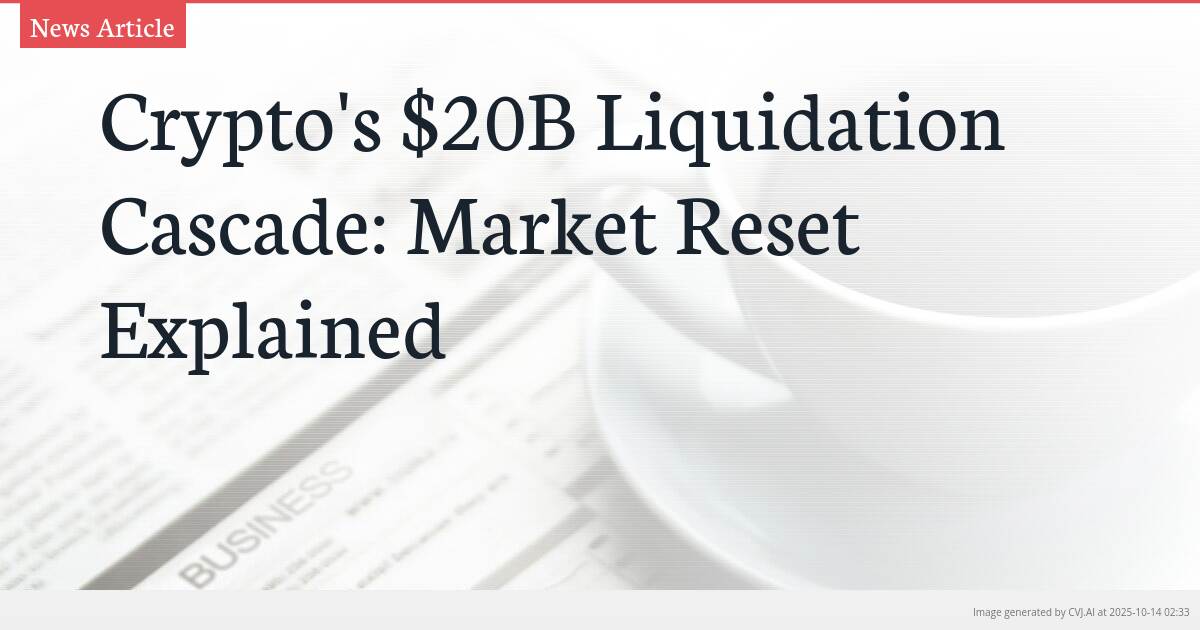This summary text is fully AI-generated and may therefore contain errors or be incomplete.
Introduction
Crypto markets experienced their largest single-day deleveraging event on record, with $19-20 billion in forced liquidations on October 10. The massive leverage purge reset positioning to July levels while revealing stark differences between Bitcoin and altcoin resilience. Despite the historic washout, major cryptocurrencies have already staged significant recoveries, signaling a healthy market reset that reduced systemic fragility.
Key Points
- Hyperliquid processed over $10 billion in liquidations while Binance accounted for $2.4 billion, with offshore exchanges absorbing the heaviest volume
- Spot Bitcoin ETF inflows turned negative on the crash day, ending a nine-day positive streak as BlackRock's IBIT inflows dropped 92% from peak levels
- Funding rates collapsed to bear market lows with Solana's eight-hour rate hitting -0.23%, indicating a dramatic shift from crowded longs to defensive positioning
The Great Deleveraging: $65 Billion Vanishes in 24 Hours
The October 10 liquidation event marked an unprecedented deleveraging in cryptocurrency markets, with approximately $19 billion to $20 billion in forced liquidations occurring within 24 hours. According to Bitwise portfolio manager Jonathan Man’s calculations, about $65 billion of futures open interest disappeared across venues during the cascade, resetting market positioning to levels last observed in July. The washout was heavily concentrated offshore, with Hyperliquid processing more than $10 billion in liquidations while Binance accounted for roughly $2.4 billion, a smaller share than typical for an event of this scale.
The distribution of liquidation volume revealed significant structural differences in market participation. Hyperliquid and Bybit absorbed the heaviest liquidation volumes, while CME maintained a larger proportion of Bitcoin futures open interest through the selloff. Coinglass data now show CME, Binance, Bybit, and OKX as the top Bitcoin futures venues by notional value, indicating a shift in market structure following the deleveraging event.
Altcoins Bear the Brunt as Bitcoin Shows Relative Resilience
The liquidation cascade revealed stark differences in market resilience between Bitcoin and alternative cryptocurrencies. Altcoins bore the brunt of selling pressure while Bitcoin’s drawdown remained comparatively contained. This divergence was particularly evident in the aftermath, with Bitcoin trading at $115,058.29 as of press time—only 8% down from its all-time high of $126,000.
Major capitalization altcoins registered significant recoveries following the initial shock. Ethereum, XRP, and Dogecoin all gained 10% since October 10, while BNB surged 15.6% in the same period after registering a new all-time high of $1,375.11 on October 13. Solana recovered 8.3% since the liquidation event, and Cardano posted a 13% recovery during the same timeframe, demonstrating the market’s ability to absorb even historic deleveraging events.
Funding Rate Collapse Signals Dramatic Positioning Shift
The liquidation event triggered a dramatic shift in market positioning, as evidenced by funding and basis compression across derivatives markets. Perpetual swap funding rates flipped negative or pinned near zero across major pairs into and through October 10 and 11. Glassnode flagged aggregate funding at the lowest reading since the 2022 bear market, confirming a clean deleveraging process.
Altcoin perpetuals showed an even sharper flip in market sentiment. Solana’s eight-hour funding rate fluctuated around -0.23% at multiple intervals on October 11, representing a rare, broad ‘pay shorts’ regime that signaled a shift from crowded longs to defensive positioning. This flip coincided with a collapse in altcoin open interest and sharp basis compression across dated futures—a classic footprint of a leverage purge centered outside Bitcoin.
By late weekend, several trackers showed monthly contracts back near 8% annualized for Bitcoin contracts on Deribit, representing a swing from mildly overheated to neutral, then a tentative re-steepening that accompanies reduced market fragility.
ETF Flows: From Record Inflows to Sudden Stall
Spot Bitcoin ETF flows played a crucial role in the market dynamics surrounding the liquidation event. Farside Investors’ data on US-traded spot Bitcoin ETF inflows show heavy net inflows earlier in the week that tapered into the crash, then flipped slightly negative on October 10. BlackRock’s IBIT brought in $899.4 million on October 7 and $426.2 million on October 8, demonstrating strong institutional demand preceding the event.
By October 9, inflows had slowed to $255.5 million from IBIT, while Fidelity’s FBTC posted a $13.2 million outflow and Grayscale’s GBTC recorded $45.5 million of redemptions, producing a combined net inflow of nearly $198 million. On the day of the crash, IBIT inflows dropped dramatically to $74.2 million, while other issuers’ inflows flipped negative. The day’s net flow turned negative by $4.5 million, ending a streak of nine consecutive days of positive net inflows.
The sequence of flows proved significant—ETF inflows between October 7 and October 8 preceded lighter net buying and October 10’s small net outflow. The combination of spot ETF demand fading right as derivatives leverage cleared helped explain the violent price wick and subsequent quick stabilization in Bitcoin prices.
Liquidity Gaps and Market Structure Implications
The liquidation event exposed critical differences in market liquidity and structure. Stress concentrated where order books were thinnest, with several altcoins briefly printing near zero on some exchanges. These leverage unwind pullbacks left momentary air pockets in specific pairs, amplifying losses in the long tail of cryptocurrency markets.
Bitcoin stabilized more quickly due to its deeper order book and developing ETF buyer base, while altcoins—lacking ETF-style demand sinks—absorbed the full brunt of derivative deleveraging through cross-margin collateral sales, negative funding across altcoin perpetuals, and patchy liquidity. The $65 billion flush of speculative positioning from the system in a single session created conditions where altcoins will likely remain more volatile than Bitcoin until leverage rebuilds and market-makers widen back in.
Despite the apparent bloodshed, the event signaled a heavy market reset. Fewer forced sellers after the flush, modest basis rebuilding, and funding grinding back toward a flat level point to a market that has shed its fragility relative to a week ago, setting the stage for potentially healthier price discovery in the weeks ahead.
📎 Read the original article on cryptoslate.com

